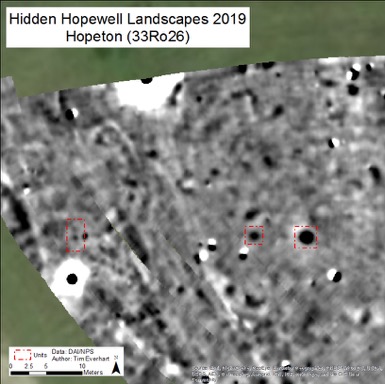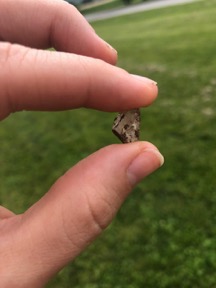Hopeton Earthworks - Week 1
Uncovering Hidden Hopewell Landscapes at Hopeton Earthworks
The Hopewell Culture archeology crew is back in the field after a year off, and we’re gearing up for one of our best seasons yet. This season, we are continuing our now five year long project to uncover and understand hidden Hopewell landscapes; this year, we’re investigating the mysterious Hopeton Earthworks.
For much of Hopewell archeology’s history, scientific research tended to focus on the mounds and fancy artifacts found within those mounds. We have, of course, learned a lot about how the Hopewell used these mounds, and we’ve especially learned a lot about how they honored their dead. But what were the Hopewell doing when they weren’t mourning? How did they celebrate life? How did they use these earthworks and the large landscapes they enclose?
 The Hidden Hopewell Landscape Project (or HHL for short) has been trying to answer some of these big picture questions since our first season at Hopewell Mound Group in 2014. Our goal is to look at what is left beneath the surface to learn more about the activities that went on within these large earthwork landscapes. To do that, we’ve relied heavily on magnetometry, a technique that sounds almost more sci-fi than science (Figure 1 - left). With magnetometry, we are able to see the shapes of highly magnetic spots; these are often created when earth is removed and replaced, burnt, or filled with items like burnt rock, ceramic, or wood. We create maps out of this information that we then use to decide where to dig. Through our partnership with the Deutsches Archäologisches Institut (German Archeological Institute), this process has helped us find two of the largest woodhenges (a circle of posts, often used in various American Indian ceremonies) in North America and has taught us that there was much more to these Hopewell enclosures than works of earth. The big question now is: how were they using all of this wooden architecture?
The Hidden Hopewell Landscape Project (or HHL for short) has been trying to answer some of these big picture questions since our first season at Hopewell Mound Group in 2014. Our goal is to look at what is left beneath the surface to learn more about the activities that went on within these large earthwork landscapes. To do that, we’ve relied heavily on magnetometry, a technique that sounds almost more sci-fi than science (Figure 1 - left). With magnetometry, we are able to see the shapes of highly magnetic spots; these are often created when earth is removed and replaced, burnt, or filled with items like burnt rock, ceramic, or wood. We create maps out of this information that we then use to decide where to dig. Through our partnership with the Deutsches Archäologisches Institut (German Archeological Institute), this process has helped us find two of the largest woodhenges (a circle of posts, often used in various American Indian ceremonies) in North America and has taught us that there was much more to these Hopewell enclosures than works of earth. The big question now is: how were they using all of this wooden architecture?
This season at Hopeton, we’ve used the magnetometry data to point us toward a largely unknown semi-circular (or maybe fully circular) structure just outside of the main Hopeton Earthworks. Looking closely at the magnetic data (Figure 1 - above), we can see dozens of spots of the map that likely represent pits and posts. This week, we’ve focused our efforts on uncovering one of the large pit features, and trying to locate one of the several possible wooden postholes (left behind when a post is put in the ground and then taken back out later).
 Our first task of the week was to begin with shovel testing. This is a process we always start out with; we set up a grid of normally twenty to thirty 50x50cm test pits (Figure 2 - right) spaced out every ten meters, and we dig these tiny holes down until we see a change in the soil color, which tells us we’ve reached the bottom of the plowed layer of soil, and therefore the original Hopewell floor surface. The purpose of these test pits is to get a sense for:
Our first task of the week was to begin with shovel testing. This is a process we always start out with; we set up a grid of normally twenty to thirty 50x50cm test pits (Figure 2 - right) spaced out every ten meters, and we dig these tiny holes down until we see a change in the soil color, which tells us we’ve reached the bottom of the plowed layer of soil, and therefore the original Hopewell floor surface. The purpose of these test pits is to get a sense for:
- what the soils in the area look like, so we know what to expect when we open our larger units, and
- the kinds of artifacts (and how many artifacts) there are in the area. This is sort of a sneak-peek at what’s to come when we begin our actual excavations, and can give us important clues about how to interpret what we find later on.
Once we made it through enough shovel tests to get a feel for the site we’re digging, it was time to finally open up our first unit. We started with a unit over top of one of the large pit features that showed up nice and bright on the magnetic data, and later on in the week added our second unit over top of the possible ring of posts. The first unit has already been quite informative; we’ve managed to strip the plowed soils off of the original Hopewell surface, and the feature has shown up boldly exactly where we expected. Before even digging into it, we’ve found several amazing pieces – including a piece of pottery, several flakes (material that comes off of stone while making stone tools), and lots of fire cracked rock (rock that gets heated up to such an extreme temperature that it eventually busts). This makes us think the pit was used for cooking or burning in some way, which could mean the area was used for a camp or for some kind of ceremonial preparation. We have a lot more to learn before we can really know what the Hopewell were up to here.
Our second unit is still a work in progress, and we have a bit more digging to do before we can even see the features we’re after. We have discovered something a little unusual – although not in the fun way that we normally like. The area seems to have a layer of rocky material that may be some kind of historic road or feature. It’s not exactly what we hoped to find, but that’s how archeology works sometimes; you don’t get what you expect!
Next week, we’ll continue looking into these features and trying to understand what they are, how they were used, and what they can tell us about the Hopewell landscape at Hopeton overall. Check back in soon for another update!
This Week’s Big Finds
Quartz crystal fragment
 This find is a rare one for this crew (Figure 3 - right); quartz crystal, while a common mineral in some areas, does not appear commonly in this part of Ohio. Finding a piece – especially one that looks like it’s been worked by someone in the past – at what we think is a Hopewell area is fascinating; the Hopewell are known to have created impressive tools and works of art out of this material, and at a site just a matter of yards away from where we are excavating now, bits of quartz crystal were found with pieces of Flint Ridge flint, a favorite stone material for the Hopewell.
This find is a rare one for this crew (Figure 3 - right); quartz crystal, while a common mineral in some areas, does not appear commonly in this part of Ohio. Finding a piece – especially one that looks like it’s been worked by someone in the past – at what we think is a Hopewell area is fascinating; the Hopewell are known to have created impressive tools and works of art out of this material, and at a site just a matter of yards away from where we are excavating now, bits of quartz crystal were found with pieces of Flint Ridge flint, a favorite stone material for the Hopewell.
Pottery
It’s very exciting to have found a piece of pottery this early in the season; usually, we’re lucky if we have one or two pieces after a six week dig. This particular piece is about the size of a fifty cent piece, and looks as though it might have some cord marking (a form of decoration made using cords wrapped around a paddle). We can’t be 100% sure this is from a Hopewell pot, but it is certainly a convincing piece.
Flakes Galore!
We’ve already found several flakes – these are sharp, flat pieces that come off of a piece of chert or flint in the process of making a stone tool. Some of the flakes we’ve found have been heat treated or burnt; we can tell based on their coloring and on special markings, like pot lid fractures that occur when a stone is heated to the point of bursting.
Figure/Picture Information:

Pic/Figure 1: Magnetic map of the area being dug at Hopeton. The dark spots represent highly magnetic areas, which could represent burning pits, posts, or other archeological features. The red squares represent the three units we hope to excavate this season. Photo courtesy of the Deutsches Archäologisches Institut.

Pic/Figure 2: Unit 1 was opened to expose the possible pit feature detected by magnetometry. The large stain in the unit floor is the very top of this feature. We will be digging into the feature next week to learn how it was used. NPS Photo / Timothy Everhart
Pic/Figure 3: Crystal quartz fragment. NPS Photo / Cailey Mullins
